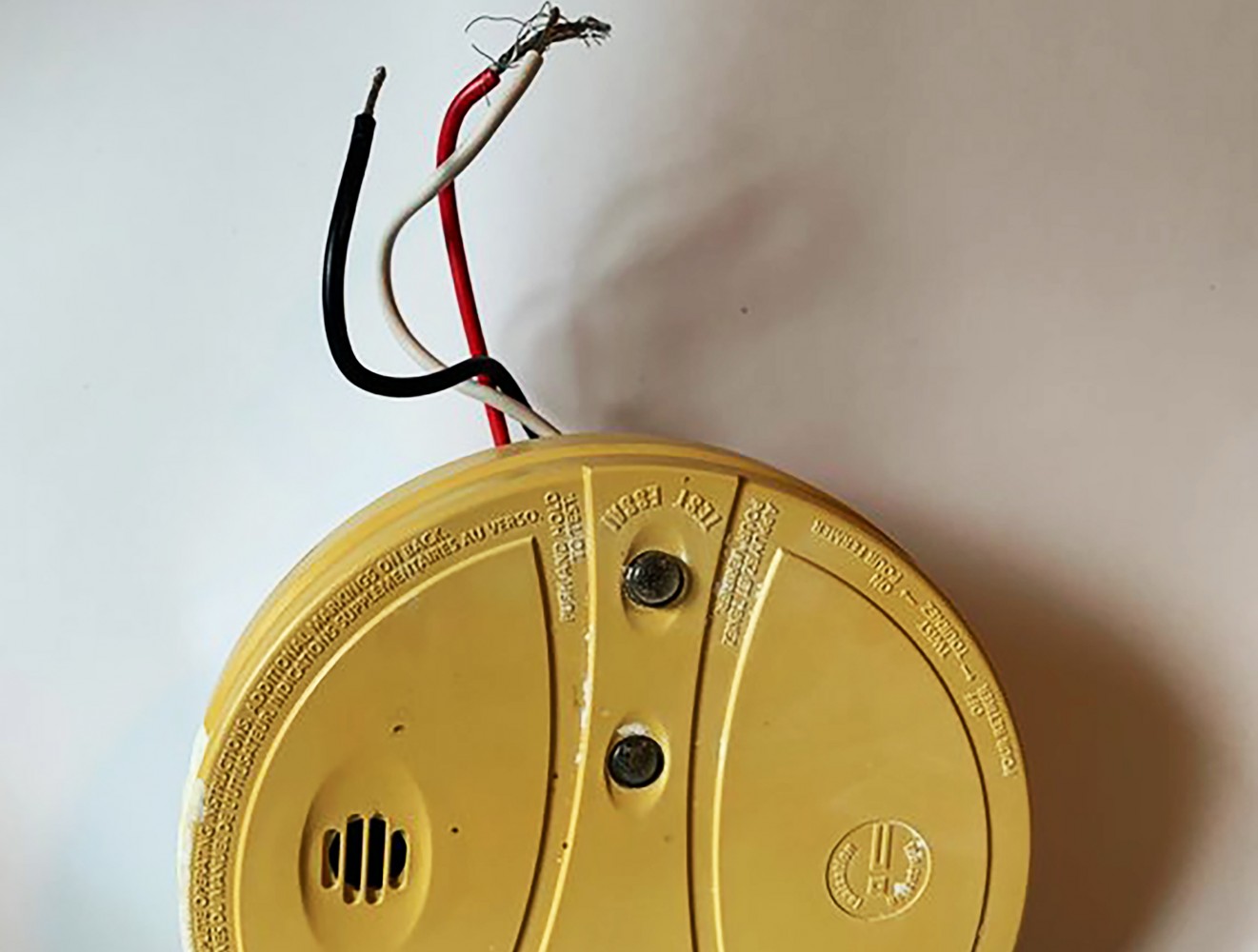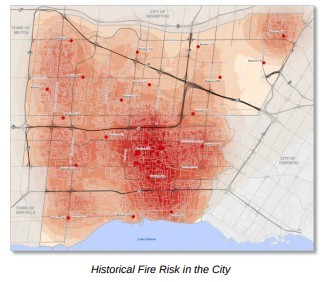
Smoke alarms save lives; why do many homes in Mississauga go without them?
“That’ll never happen to me.”
It’s an attitude Nigel Robinson, a Division Fire Chief with Mississauga Fire Service (MFES) says many people hold when it comes to house fires. It can lead to fire safety plans left unfinished, smoke alarm batteries left unchecked—or not installed at all. Nobody wants to think about their house, a place of safety, happiness and shelter, being consumed by flames. It’s easier to push it away and say, “That’ll never happen”.
In 2020, 126 families were wrong.
“Many people don't think that fire will occur in their home, they don't recognize the importance of having these life saving devices,” says Nigel Robinson, Division Chief Fire Prevention and Life Safety.
Fire is an unforgiving force.
It spreads rapidly through homes, fuelled by lightweight construction materials and modern furniture, which typically consists of little more than sawdust and glue. The unpredictability, destruction and speed can make the job of firefighting difficult, especially if fire services are struggling to get to the site within a matter of minutes. In a house fire, each second lost can mean the difference between life or death—smoke alarms provide one of the cheapest, and easiest ways to detect a fire before it gets too big, and for families to get out safely. Yet, MFES is finding many of the homes that go up in flames in the city don’t have them.
Of the calls MFES responded to in the past five years an average of 43 percent of incidents had no working smoke alarm and 60 percent either had no working smoke alarms or the presence could not be determined.
The fire department is attempting to reduce these statistics over the next few years by implementing more educational outreach programs.
(Mississauga 2022 budget)
Following a tragic January house fire in Brampton that claimed the lives of three young boys, Brampton’s Fire Chief, Bill Boyes took the opportunity to remind residents of the importance of these devices.
“Please make sure you have working smoke alarms, make sure you have an escape path and you know what to do in the event of a fire,” Boyes said to the media. “We really want everybody to be cognizant of fire safety right now and use this very tragic, unfortunate situation as a reminder about the importance of fire safety.”
The Ontario Fire Marshal has not determined if there was a smoke alarm present in the home.
The chances of survival increase two fold when a smoke alarm is present, making it one of the best ways to avoid a deadly fire. It is the law in Ontario to have one on every level of residential buildings, but MFES finds households are not complying.
The dearth of these devices, when combined with a fire service that is struggling to meet mandated response times in a growing city poses pressing safety concerns.
MFES aims to have the first vehicle reach the site of a fire within four minutes 75 percent of the time. This is lower than the National Fire Protection Association (NFPA) target, which is 240 seconds (four minutes) or less 90 percent of the time.
In 2020, on average, MFES didn’t meet this lower threshold, arriving on scene 298 seconds (almost five minutes) 75 percent of the time. MFES says traffic congestion and ongoing construction throughout the city both contributed to the long response times. A lack of investment in new fire stations over the last decade also means Mississauga’s firefighters are travelling longer distances to reach certain parts of the city.

A look at the locations of Mississauga's fire stations compared to the high risk fire areas in the city.
(Mississauga Fire and Emergency Services)
While this lack of investment is showing signs of changing in the 2022 budget—the service received a 3.5 percent budget increase this year—it is also improving their prevention tactics, hoping to stop fires before they start.
According to the 2022 budget, nearly 60 percent of fires are unintentional. The causes of most fires in the city are discarded smoking materials, unattended cooking and mechanical or electrical failures. A large portion of Mississauga’s buildings are residential, which includes single family homes and multi-unit dwellings.
The most at-risk population in Mississauga, and around the world, in the event of a fire, are older adults above the age of 65. Those with disabilities are at an even higher risk of being injured or killed in a house fire. According to a 2017 literature review by Dr. Joe Clare and Hannah Kelly from Murdoch University, aging populations further stretch services and the abilities of fire departments as these individuals may struggle to escape a fire in a timely manner.
“If preventative measures are not put in place it is likely the amount of fire-related casualties among this demographic will only increase with time,” the researchers wrote.
With 95 percent of Mississauga’s building stock being residential, approximately 64 percent of fires in the last five years have occurred within these buildings. In 2020 that number rose to 71 percent, due to more people staying home during the pandemic. There were no fatalities due to fires in residential buildings in 2020, but there have been nine in the past five years.
Smoke alarms not only help prevent a fire from becoming worse—potentially allowing a person time to extinguish small flames—lessening the burden on fire services, but the piercing alarm is also a family’s eyes and ears while they sleep.
Approximately 32.6 percent of people killed in residential fires were asleep and 30.9 percent were impaired according to Clare and Kelly’s research.
According to a study done by Underwriter Laboratories, a non-profit product safety testing organization, it found newer materials, like bedding, blankets and upholstery caught fire much quicker than older, solid materials. Tests like these have been done often and all share the same results, showing reliance on plastic and chemically treated items for furniture and other items creates an added danger in a fire.

A home filled with modern synthetic materials will burn much faster than one filled with older, natural furniture.
(UL FSRI Home Furnishings Comparison (Natural vs. Synthetic) - YouTube)
When a house fire does occur, people get caught in thick, black smoke making it hard for them to find an escape route. The NFPA says most fire deaths are the result of smoke inhalation. With more synthetic materials in homes fires give off smoke with more chemicals. These toxic gases replace oxygene much quicker. In a rapidly burning house fire, people have three minutes or less to escape before the effects of smoke inhalation can paralyze them.
In high-rise buildings home to multiple units, the responsibility of working fire systems falls on the property manager. This includes conducting routine inspections and testing to ensure the devices are working. In single dwelling units, the responsibility is on the homeowner to make sure smoke alarms have batteries and are working correctly.
Robinson, a Division Fire Chief with MFES, explains a lack of education and contributes to violations of the law in all types of residential and industrial settings.
“The National Fire Protection Association (NFPA) statistics show the primary reasons that smoke alarms aren't working in the home are either disconnected or depleted batteries,” he says. “Which is why codes and standards have changed to really push for hardwired smoke alarms to be installed in the homes.”
In some instances, MFES sees alarms installed too close to cooking areas, causing them to go off unreliably. This sometimes leads people to unplug or take out the batteries, defeating the purpose of the device. To ensure these common mistakes don’t continue to happen, MFES have increased fire prevention and education programs this year.
Mississauga does not include statistics of how many fire alarms were found to be unplugged or did not have working batteries, but research by Clare and Kelly found that of a sampling of nearly 1,200 adults aged 65 and older about 84 percent owned an alarm, but only 72 percent of them were working properly. This study also found disconnected or dead batteries were the most common reason for the alarm not working.
A further challenge presented to MFES is the approximately 211,000 households who do not speak English or French as their first language. In order to protect residents and educate them, MFES has committed to making sure the educational messages are translated in a variety of languages so all residents can understand them.
According to the service’s 2019 Fire Master Plan, the most common non-official languages spoken in Mississauga are Urdu, Punjabi and Polish.
One way of reaching the city’s diverse population is by partnering with local businesses/organizations. By bringing smoke alarms right to residents and arming them with knowledge to protect themselves. Robinson told The Pointer MFES is distributing 500 dual smoke and carbon monoxide alarms to Mississauga Food Bank users in early 2022.
On top of handing out alarms, the City’s budget indicates two additional public education officers are being hired to continue promoting education and fire prevention initiatives.
Many fire departments also use a variety of creative means to reach different demographics with their education programs, with the hope of having their messaging reach as many people as possible.
The Peel Safety Village hosts an model home where children have the opportunity to find fire hazards and learn where to go when a fire occurs. The fire department offers grade school children the chance to understand fires and be prepared in case one does occur.
Similarly, the City of Cambridge has funded a full educational village aimed at teaching grade school children the importance of a fire escape route and how to call 911.
One successful program MFES runs is a fire inspection program, allowing inspection officers inside homes and businesses to make sure alarms are in working condition and are in the correct locations to serve the building. This accomplishes the dual purpose of educating building owners and preventing fires. In 2022, the department will be hiring seven more inspectors to expand the program.
“When we visit homes, we take the additional time to test the smoke alarms and remind the residents how they operate,” Robinson told The Pointer. “If we find a home that is without an alarm, we look at any measure possible including installing a battery operated one as an interim device until they can replace one or where necessary, give it to the homeowners.”
In 2022, the additional inspection officers will allow the service to inspect all medium and high hazard industrial sites annually. An additional fire safety engineer is also being hired to help address new builds and the Ontario Building Code requirements for them.
Routine check-ins on high and medium risk industrial sites have previously been conducted on a biannual basis. This group of buildings are more likely to have catastrophic fires due to more combustible materials inside. In Mississauga, only 1.9 percent of buildings have an industrial classification despite representing 11.6 percent of fires, 1.5 times the provincial average.
For prevention efforts in 2022, Mississauga fire is spending $9.4 million in continuing education and inspection programs.
Unlike the fires they are designed to prevent, awareness and education initiatives require a lot more time to take hold. MFES officials say the service will continue to prioritize the knowledge of smoke alarms in hope of stopping large scale fires and deaths in the community before they happen.
Email: [email protected]
Twitter: @taasha__15
COVID-19 is impacting all Canadians. At a time when vital public information is needed by everyone, The Pointer has taken down our paywall on all stories relating to the pandemic and those of public interest to ensure every resident of Brampton and Mississauga has access to the facts. For those who are able, we encourage you to consider a subscription. This will help us report on important public interest issues the community needs to know about now more than ever. You can register for a 30-day free trial HERE. Thereafter, The Pointer will charge $10 a month and you can cancel any time right on the website. Thank you
Submit a correction about this story


